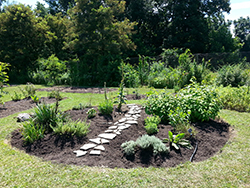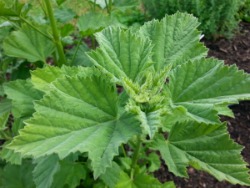A place of quiet, communion, and learning, the MUIH herb garden is a haven for all who visit, work, and study on our campus. The herb garden also provides students with an opportunity to gain hands-on experience gathering and tending medicinal plants and offers a living example of many of the herbal medicines used in the Natural Care Center and Herbal Dispensary.

The quarter-acre herb garden contains more than 125 medicinal plant species from around the world, including vegetation of multiple habitats and ecosystems. While most of the medicinal plants are from the Native American, North American and European traditions, a variety of them come from the Ayurvedic and the Chinese medicine traditions.
The garden includes everything from small herbaceous plants and vines to shrubs and trees, annuals to perennials, natives and non-natives. Some of the herbs in the garden include St. John’s Wort, Wormwood, Meadowsweet, Holy Basil, Marshmallow, Feverfew, Licorice, Ashwagandha, Echinacea, Turmeric, Burdock, Comfrey, Ginger, Chaste Berry, and Elderberry.
Medicinal plants are located in close proximity to each other, labeled and organized into multiple demarcated garden beds, making them easy to identify and learn about. While this design is not typically how the plants are found in nature, it ensures that the plants are clearly identifiable which facilitates learning for students and visitors. Subsequently, when walking in the surrounding wild areas on campus, where plants are intermingled together, the process of plant identification becomes easier.
Sustainable Garden Management
Permaculture principles are applied to the garden design enabling it to be more in harmony and balance with the rhythms and energies of nature. These permaculture principles drive and shape the sustainable and regenerative approaches used to manage water, weeds, wildlife and waste in the garden. Rainfall is captured using the contours of the land and garden beds. Weeds are managed manually by hand. Waste is composted. Insect pests are managed using companion plants, not pesticides or chemicals. Wildlife destruction of the garden is prevented through the use of various layers of fencing.
Different microclimates have been created that enable the garden to support a diverse set of medicinal herb populations in a small area. Certain areas of the garden mimic moist marshy environments allowing marshmallow and calamus to thrive, while other areas mimic sunlit grassland conditions allowing echinacea and yarrow to grow.
|
Marshmallow From the European tradition, Marshmallow is the plant that marshmallows were originally made out of in ancient times. For medicinal purposes, the root is infused in cold water to make a gooey tea that is soothing to inflamed & irritated mucus membranes of the gastrointestinal, genitourinary tract and upper respiratory tracts. |
Bee Balm From the Native American traditions, Bee Balm was used for nausea and flatulence associated with food poisoning. It comes in handy for tension headaches and sinus infections, thanks to its aromatic compounds. The aroma and taste are just like culinary Oregano, but stronger. When in bloom, the bees tend to spend a lot time with its flowers.
|

Hops With a long history of use in Europe, Hops was not only used in beer, but it also makes a great medicine useful for stress-related digestive upset. Another common use is for various kinds of insomnia, where hormones or stress are a major factor. Its bitter taste is what makes it so effective for digestive issues, but it makes taking it in a tea, not so tolerable. |

Passionflower Passionflower was used in the Native American traditions and is useful for insomnia caused by excessive thinking and worry. It also is useful to reduce anxiety and to calm down spasms in the body. Its a vine, with one of the most beautiful flowers in the plant kingdom. |
Awards & Recognition
The MUIH herb garden has been acknowledged as a United Plant Savers (UpS). Botanical Sanctuary and a Sacred Seeds Sanctuary Foundational Garden.
“UpS Botanical Sanctuaries not only serve as rich depositories for ‘at risk’ North American medicinal plants, but also serve as educational centers for plant conservation and organic cultivation.”
—United Plant Savers (www.unitedplantsavers.org)
“Sacred Seeds is a network of sanctuaries preserving biodiversity and plant knowledge. We accomplish this through living gardens containing locally important plants, focusing on medicinals but including those of ceremonial, food, and craft value. “
– Sacred Seeds (www. sacredseedssanctuary.org)
Conservation of Endangered Medicinal Plants
Due to overharvesting and other human activities, a variety of native medicinal plants have been deemed “At-Risk” of being endangered, and “To-Watch” to prevent endangered status by United Plant Savers, an organization advocating for the protection of native medicinal plants. The MUIH herb garden contains a variety of these endangered plants as way to build awareness and educate the public about medicinal plant conservation. The chart below shows some of the plants in our garden with their UpS designation.
| “At-Risk” Plants | “To-Watch” Plants |
|
|

Community Herb Walks
Herb Walks are offered to the public so that we can more broadly share our knowledge of and respect for medicinal plants. Attendees spend most of their time in the herb garden getting the opportunity to see, smell and/or touch various herbs. They learn about medicinal uses for the different plants, harvesting approaches, medicine making tips, historical stories, conservation issues and more. A brief tour of the surrounding wild areas of the campus is included.
Herb Garden Internship Program
Student interns sustainably maintain the garden and this opportunity creates experiential learning opportunities. Interns work alongside the herb garden manager doing regular activities such as weeding, planting, creating garden beds, and maintaining plants.
Connections
Herbal medicine has a foundation in the wisdom traditions of the world and an intimate connection with nature. The MUIH herb garden honors these traditions and provides a space for this connection. It is quite complementary to the healing, learning and transformation that is part of the University’s culture.
 ‘
‘